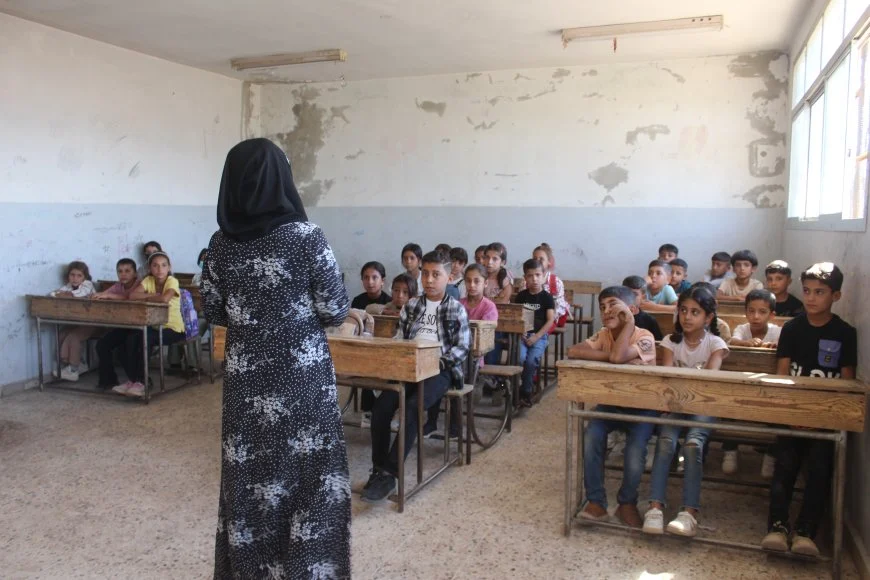Northeast Syria schools reopen as tighter curriculum policy risks deepening rift with Damascus

Schools in northeast Syria have reopened for the first academic year since the Assad regime’s collapse. The northeast Syrian administration has tightened enforcement of its own curriculum while negotiations with the new Syrian government inch forward with little progress.
Context: The SDF-led northeast region continues to operate its own network of schools, where more than 713,000 students are taught by 35,500 teachers. Of the 3,742 schools under its authority, 95 remain closed as they continue serving as shelters for displaced families from Afrin and elsewhere. Classes are conducted in Kurdish, Arabic, and Syriac. In the region, each school averages 196 students and about ten teachers, creating a student-teacher ratio of approximately 20 to 1.
Beyond the northeast, according to figures released by the Syrian Ministry of Education in June, government schools now serve about 4.2 million students, staffed by some 253,000 teachers. The ministry counts 19,426 schools nationwide, though nearly 40 percent—7,849 buildings—remain unusable after years of war, leaving just over 11,500 functional schools. This produces an average of 363 students per school, staffed by roughly 22 teachers, creating a student-teacher ratio of around 16 to 1. The system is centralized, with larger schools absorbing heavy student loads, often requiring double-shift schedules in urban centers.
Combined, the two systems bring the total number of students enrolled inside Syria to just under 4.9 million, with nearly 288,500 teachers across more than 23,000 schools. The northeast region accounts for around 14% of all students and 12% of teachers, but nearly a quarter of the country’s functional schools.
Analysis: As negotiations between Damascus and northeast Syria continue, education has emerged as a potential new flashpoint. The northeast administration has decided to tighten restrictions on Damascus curricula in private schools within areas under its control. Previously, the northeast Syrian administration was relatively flexible about allowing government curricula in private schools, particularly in Arab-majority areas where the population had pushed back against the regional curriculum. However, the administration is now reportedly ending this practice and has decided to unify curricula across all public and private schools in the region.
Education in Syria is now split between two systems that reflect the country’s political divide. Schools run by the transitional government in Damascus and those under the SDF administration teach vastly different content, languages, and values.
Northeast Syria Education Data as % of Syria Total
Students (~4.9M Total)
AANES: 14.5%
- Gov. of Syria
- AANES
Functional Schools (15,224 Total)
AANES: 24%
- Gov. of Syria
- AANES
Government of Syria Data
AANES / Northeast Syria Data
In Damascus-run areas, Baathist-era indoctrination has been stripped out. The “National Education” subject—long a vehicle for party loyalty—has been abolished, with its exam weight temporarily shifted to religious education while committees draft a non-partisan civics course. Textbooks are being revised to remove slogans and propaganda, but the structure remains familiar: Arabic-medium instruction, English or French as foreign languages, and national exams in Grades 9 and 12.
In the northeast, the administration has gone further, building a separate curriculum with an explicitly ideological foundation. Textbooks are published in Kurdish, Arabic, and Syriac; primary education starts in a child’s mother tongue before moving to bi-/trilingual study. Content absent from Damascus’s books is foregrounded—Kurdish history, geography, and culture (including, at times, maps of Kurdistan). A new secondary-level subject, Jineology (“the science of women”), introduces feminist theory and the writings of Abdullah Öcalan. Civics focuses on local governance, communal democracy, and pluralism, aligning with the northeast’s political project.
Religion represents another major divergence point. Damascus-run schools continue to teach Islamic (or Christian) education as a core subject, now more central after the removal of “National Education.” The northeast has eliminated formal religion classes, replacing them with ethics and social studies—changes that have prompted pushback in Arab-majority areas such as Deir ez-Zor and Raqqa, where families view the omission as hostile to local traditions.
The differences extend to credential recognition. Certificates issued by Damascus are valid nationwide and internationally, while northeast diplomas remain unrecognized by the Syrian state. Students in the northeast who wish to attend Syrian universities often face significant obstacles unless they transfer to Damascus’s program. This recognition gap represents a major point of contention, as it directly affects students’ futures, an issue that may cause serious problems unless resolved.









